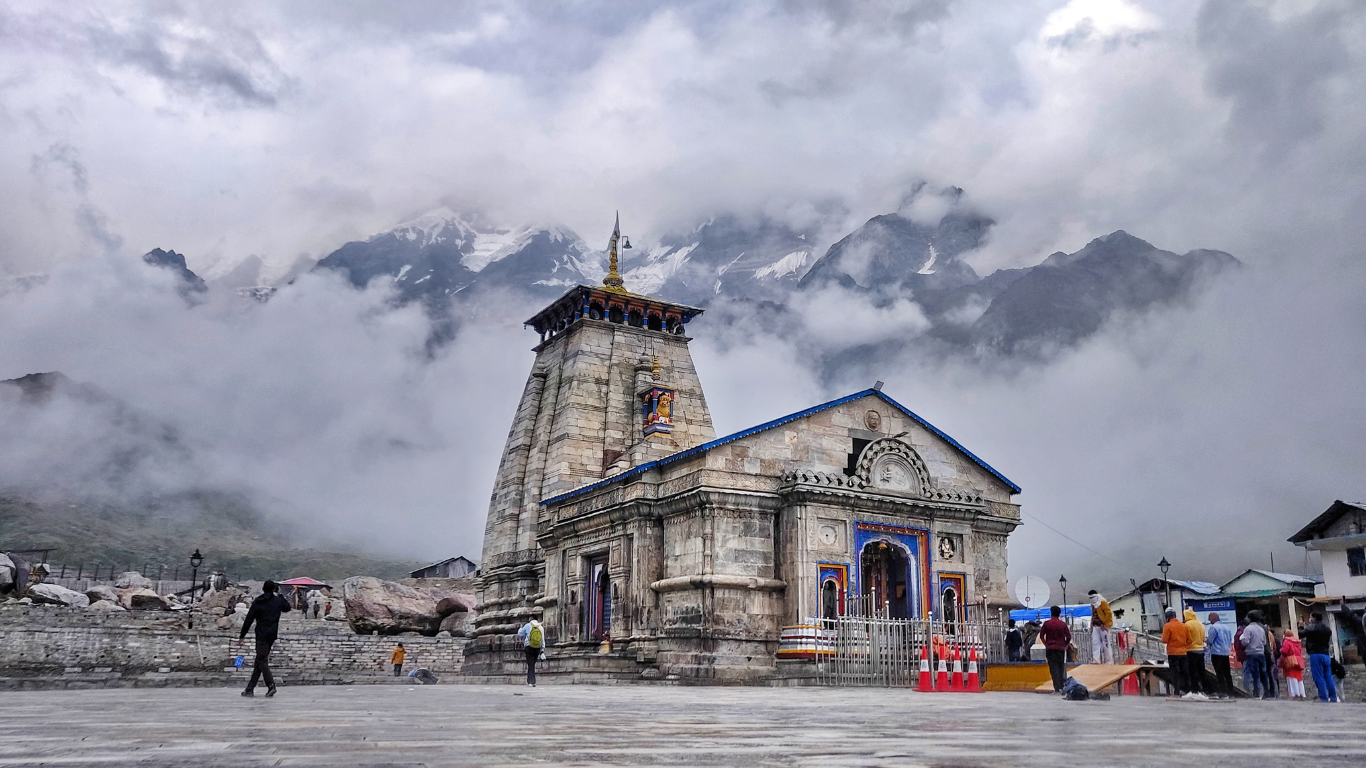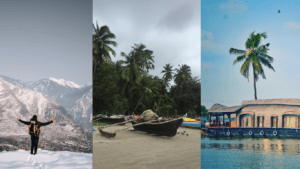The journey from Kedarnath to Badrinath is a sacred pilgrimage in India’s Uttarakhand, connecting two holy shrines of the Char Dham Yatra. Kedarnath, dedicated to Lord Shiva, and Badrinath, devoted to Lord Vishnu, draw millions yearly. The distance between them is about 243 km by road, but the rugged Himalayan terrain makes it a unique adventure. Travel options include buses, taxis, or helicopters, with stunning views of mountains and rivers. This article explores the Kedarnath to Badrinath distance, travel routes, tips for pilgrims, and spiritual significance. Whether you’re planning a trip or curious about this holy route, let’s dive into what makes this journey special, as of June 7, 2025.
Understanding the Distance and Terrain
The road distance from Kedarnath to Badrinath is roughly 243 km, taking 8-10 hours by car or bus, per Uttarakhand Tourism. The actual distance depends on the route, as Kedarnath requires a 16-18 km trek from Gaurikund, while Badrinath is accessible by road. The Himalayan roads are narrow, winding, and prone to landslides, especially during monsoons (July-September). The aerial distance is shorter, about 41 km, making helicopters a quick option (30-40 minutes), per heliyatra.irctc.co.in. Altitude matters—Kedarnath sits at 3,583 meters, Badrinath at 3,133 meters—so acclimatization is key. Weather can delay travel, so check forecasts and plan for May-June or September-October for safer trips.
Road Distance Details
The road journey from Kedarnath to Badrinath covers 243 km, starting from Gaurikund (base for Kedarnath) to Badrinath via Rudraprayag and Joshimath, per yatra2yatra.com. The route follows NH-7, with sharp curves and steep climbs. Travel time varies—8 hours for taxis, 10 for buses—due to road conditions. Monsoon landslides can add delays, as noted by @uttarakhand_travel on X. Rest stops like Rudraprayag offer food and lodging. Always carry water and snacks, as remote stretches lack shops.
Aerial Distance and Helicopter Options
The straight-line distance between Kedarnath and Badrinath is 41 km, per distancefromto.net. Helicopters cut travel time to 30-40 minutes, costing ₹7,000-12,000 per person, per heliyatra.irctc.co.in. Services like Pawan Hans operate from Gaurikund to Badrinath, with bookings online or via agents. Weather can ground flights, so confirm schedules. X users like @pilgrim_diary praise helicopters for saving time but note limited seats. It’s ideal for elderly pilgrims or those short on time.
Popular Travel Routes
The most common route from Kedarnath to Badrinath is Gaurikund to Rudraprayag (76 km), then Joshimath (164 km), and finally Badrinath (3 km). This 243-km journey passes scenic spots like the Alaknanda River, per uttarakhandtourism.gov.in. Another route via Chopta is slightly longer (260 km) but offers views of Tungnath. Buses and taxis are affordable, starting at ₹500 for shared cabs, per yatra2yatra.com. Helicopters follow a direct path, landing near Badrinath’s temple. Each route has unique charm, but road travel lets you soak in the Himalayas’ beauty, despite bumpy roads and occasional traffic.
Gaurikund to Rudraprayag
From Gaurikund, the base for Kedarnath, the road to Rudraprayag is 76 km, taking 2-3 hours, per yatra2yatra.com. You’ll pass Sonprayag and the Mandakini River, with stunning valley views. The road is narrow, so skilled drivers are a must. Shared taxis cost ₹200-300, while private ones are ₹2,000, per local operators. X posts like @kedar_traveler warn of monsoon roadblocks. Rudraprayag has hotels and dhabas for rest, making it a key stop before heading to Joshimath.
Rudraprayag to Badrinath
The 167-km stretch from Rudraprayag to Badrinath, via Joshimath, takes 5-7 hours, per uttarakhandtourism.gov.in. You’ll drive along the Alaknanda River, passing Karnaprayag and Chamoli. Roads are steep, with hairpin bends, so travel early to avoid night driving. Shared buses cost ₹400-600, taxis ₹4,000-6,000. Joshimath, 44 km from Badrinath, offers a night halt with guesthouses. X users like @badrinath_yatra suggest stopping at Vishnu Prayag for photos. Check for road updates, as landslides are common.
Spiritual Significance of the Journey
The Kedarnath to Badrinath journey is a sacred part of the Char Dham Yatra, honoring Shiva and Vishnu. Kedarnath’s temple, one of 11 Jyotirlingas, is a site of spiritual cleansing, per bharattemples.com. Badrinath, a Vishnu shrine, is believed to grant moksha (liberation). Pilgrims feel a deep connection to divinity, with the 243-km route symbolizing devotion through tough terrain. X posts like @spiritual_india share stories of peace after visiting both. The journey teaches patience and faith, drawing 2.5 million pilgrims yearly, per Uttarakhand Tourism, seeking blessings and inner strength.
Kedarnath’s Spiritual Role
Kedarnath, at 3,583 meters, is a sacred Shiva temple where devotees seek forgiveness and strength, per bharattemples.com. The 16-18 km trek from Gaurikund tests endurance, symbolizing spiritual effort. Pilgrims offer prayers to the Jyotirlinga, believed to remove sins. X users like @kedar_devotee describe life-changing visits, with 1.2 million pilgrims in 2024, per yatra2yatra.com. The temple’s remote location, amidst snowy peaks, deepens its mystical pull, making it a must-visit before Badrinath.
Badrinath’s Divine Importance
Badrinath, dedicated to Vishnu, is one of India’s holiest sites, promising spiritual liberation, per bharattemples.com. Located at 3,133 meters, its temple by the Alaknanda River draws 1 million visitors yearly, per Uttarakhand Tourism. Devotees pray for prosperity and peace, with rituals like Maha Abhishek costing ₹4,300, per badrinathtemple.com. X posts from @badrinath_yatra highlight its serene vibe. Visiting after Kedarnath completes the Char Dham, balancing Shiva’s power with Vishnu’s grace for a fulfilling pilgrimage.
Travel Tips for Pilgrims
Planning the Kedarnath to Badrinath journey needs care. Travel in May-June or September-October to avoid monsoon risks, per uttarakhandtourism.gov.in. Book accommodations in Gaurikund, Rudraprayag, or Joshimath early, as hotels fill fast (₹1,000-3,000/night). Carry warm clothes, as temperatures drop to 5°C, and pack rain gear. Register for the Yatra at e-pass portals, per yatra2yatra.com, to avoid delays. Stay hydrated, carry snacks, and use oxygen cans at high altitudes. X users like @pilgrim_diary suggest hiring local guides for the Kedarnath trek. Respect temple rules and avoid littering to honor the sacred sites.
Best Time to Travel
May-June and September-October are ideal for the 243-km journey, with clear skies and temperatures of 10-20°C, per uttarakhandtourism.gov.in. Monsoons (July-August) bring landslides, closing roads, as @uttarakhand_travel warns. Winter (November-April) shuts Kedarnath’s temple, and Badrinath is tough to reach due to snow. Plan for early morning starts to avoid traffic and enjoy daylight views. Check weather apps like AccuWeather for updates. These months ensure safer, more comfortable travel for pilgrims.
Packing Essentials
Pack warm layers, like jackets and thermals, as Kedarnath and Badrinath hit 5-10°C, per yatra2yatra.com. Carry sturdy trekking shoes for Kedarnath’s 16-km hike and a raincoat for sudden showers. Bring a water bottle, dry fruits, and energy bars, as food stalls are sparse. A first-aid kit with altitude sickness meds, like Diamox, helps, per Healthline. X users like @kedar_traveler recommend portable oxygen cans for high altitudes. A small backpack keeps essentials handy while keeping you light for the journey.
Challenges and Safety Concerns
The Kedarnath to Badrinath route is tough due to its high altitude and rugged roads. Landslides, especially in monsoons, block highways, delaying travel, per @uttarakhand_travel on X. Kedarnath’s trek is strenuous, with 3,583-meter elevation causing breathlessness for some, per Mayo Clinic. Badrinath’s roads are narrow, increasing accident risks. Carry ID, register at Yatra checkpoints, and avoid night travel. Emergency helplines (112) and local police help, per uttarakhandtourism.gov.in. Acclimatize in Rudraprayag or Joshimath to avoid altitude sickness and ensure a safe pilgrimage.
Altitude Sickness Risks
At Kedarnath (3,583 m) and Badrinath (3,133 m), altitude sickness can cause headaches, nausea, or dizziness, per WebMD. About 20% of pilgrims face mild symptoms, per Healthline. Rest in Gaurikund or Joshimath for a day to adjust. Drink water, avoid heavy meals, and consider meds like Diamox, prescribed by doctors. X users like @pilgrim_diary suggest slow trekking and oxygen cans. If symptoms worsen, descend to lower altitudes and seek medical help at local clinics.
Road Safety Issues
The 243-km road has narrow, winding stretches, especially near Joshimath, with risks of landslides, per yatra2yatra.com. Monsoon rains cause delays, as @badrinath_yatra notes. Hire experienced drivers for taxis, and avoid overcrowded buses. Night driving is risky due to poor visibility, so start early. Check road updates via Uttarakhand Police or apps like MapMyIndia. Carry a flashlight and emergency contacts. These steps, backed by local advice, keep the journey safer despite challenging Himalayan conditions.
Cost and Booking Options
The Kedarnath to Badrinath trip costs vary. The Kedarnath trek is free, but ponies or palanquins cost ₹3,000-7,000, per yatra2yatra.com. Taxis from Gaurikund to Badrinath range from ₹4,000-6,000, buses ₹500-800, per uttarakhandtourism.gov.in. Helicopters cost ₹7,000-12,000 one-way, per heliyatra.irctc.co.in. Accommodations in Rudraprayag or Joshimath cost ₹1,000-3,000/night. Book Yatra e-passes online and reserve hotels or helicopters early via IRCTC or GMVN sites. X users like @kedar_traveler suggest group bookings for discounts. Budget ₹10,000-20,000 per person for a 3-4 day trip, covering travel and stay.
Budgeting for the Trip
A 3-4 day trip costs ₹10,000-20,000 per person, including transport, food, and lodging, per yatra2yatra.com. Shared taxis save money (₹500-800), while private ones are pricier (₹4,000-6,000). Meals at dhabas cost ₹100-200 each. Kedarnath’s trek is free, but porters or ponies add ₹3,000-7,000. Badrinath’s temple entry is free, but special poojas cost ₹2,000-4,000, per badrinathtemple.com. X users like @budget_pilgrim recommend carrying cash for remote areas. Plan ahead to avoid overspending.
Booking Transport and Stay
Book buses or taxis through GMVN or local agents in Rishikesh, per uttarakhandtourism.gov.in. Helicopter tickets are available via heliyatra.irctc.co.in, starting at ₹7,000. Reserve hotels in Gaurikund, Rudraprayag, or Joshimath on Yatra.com or GMVN sites, costing ₹1,000-3,000/night. Yatra e-passes are mandatory, free via registration.uk.gov.in. X posts from @badrinath_yatra suggest early bookings, especially in May-June, as slots fill fast. Confirm all bookings to avoid last-minute hassles during the pilgrimage season.




